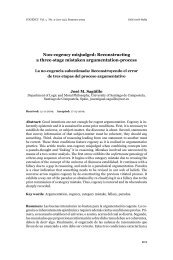Cogency v2 n2
Cogency v2 n2
Cogency v2 n2
Create successful ePaper yourself
Turn your PDF publications into a flip-book with our unique Google optimized e-Paper software.
COGENCY Vol. 2, N0. 2, Spring 2010<br />
unshakable foundations. In this picture we find the roots of the following<br />
idea: “‘You can’t go on having one thing resting on another; in the end there<br />
must be something resting on itself.’ (The a priori) Something firm in itself”<br />
(PO, p. 407). To this Wittgenstein gives this curt (but we think reasonable)<br />
response: “I propose to drop this mode of speech as it leads to puzzlements”<br />
(ibid.). Notice that Wittgenstein does not engage in a refutation of a<br />
thesis through argument, but rather proposes the changing of a conceptual<br />
picture – the very way a subject is conceived – by changing the language<br />
applied to the subject. His reasons (implicit in this case) are that the problems<br />
(disquietudes) arising from the first picture do not arise in the second;<br />
thus the problem is dissolved–rather than solved through the discovery and<br />
presentation of evidence.<br />
To sketch another example: Wittgenstein recommended comparing mathematical<br />
equations to rules, rather than – as their surface grammar suggests<br />
– to truth-claims. For this, he urged, would help us escape the disquieting<br />
back-and-forth debate over what these propositions might be about –<br />
while at the same time highlighting their important normative function in<br />
practices that permeate our lives as rational animals. Here again Wittgenstein<br />
is encouraging philosophers to put aside a captivating but misleading comparison<br />
or “picture.”<br />
Philosophical argumentation of the kind Wittgenstein practiced and recommended<br />
is inherently persuasive – its function is dialectical rather than<br />
demonstrative. It serves, not to establish a conclusion, but to reorient our<br />
thinking. Rather than proving something (e.g., a “platonic” as contrasted<br />
with a conceptualist theory of numbers), Wittgenstein offered philosophy a<br />
“means of rescue” from its metaphysical “fly-bottles.” 31 Admittedly, the persuasions<br />
found in his writings are not rational in the sense of “certifiable<br />
within standard rules of deductive and inductive inference.” But “rational”<br />
surely has a broader sense than that. Wittgenstenians will call it a family<br />
resemblance term and argue for including their philosophical persuasions<br />
in the family. And a few of us will even suggest that some of “what happens<br />
31<br />
The “theraputic,” ad hoc, and (we think) appropriately ad hominem character of philosophical<br />
argumentation as Wittgenstein practiced it is suggested by the following striking<br />
remark from CV, p. 43c, 1942: “At present we are combating a trend. But this trend will die<br />
out, superseded by others, and then the way we are arguing against it will no longer be<br />
understood; people will not see why all this needed saying.”<br />
74








